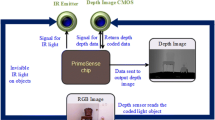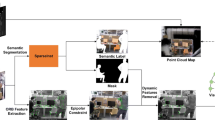Abstract
Localization is an essential step in visual navigation algorithms in robotics. Some visual navigation algorithms define the environment through sequential images, which are called visual path. The interval between each consecutive image is called a segment. One crucial step in these kinds of navigation is to find the segment in which the robot is placed (segment self-localization). Visual segment self-localization methods consist of two stages. In the first stage, a feature matching between the current image of the robot with all the images that form the visual path is done. Usually, in this stage, outliers removal methods such as RANSAC are used after matching to remove the outliers matched features. In the second stage, a segment is chosen depending on the results of the first one. Segment self-localization methods estimate a segment depending just on the percentage of the matched features. This leads to estimate the segment incorrectly in some cases. In this paper, another parameter also is considered to estimate the segment. The parameter is based on the perspective projection model. Moreover, instead of RANSAC which is a stochastic and time consuming method, a more straightforward and more effective method is proposed for outliers detection. The proposed methods are tested on Karlsruhe dataset, and acceptable results are obtained. Also, the methods are compared with three reviewed methods by Nguyen et al. (J Intell Robot Syst 84:217, 2016). Although the proposed methods use a more straightforward outlier method, they give more accurate results.










Similar content being viewed by others
References
Nguyen T, Mann GKI, Gosine RG, Vardy A. Appearance-based visual-teach-and-repeat navigation technique for micro aerial vehicle. J Intell Robot Syst. 2016;84:217.
Mahadevaswamy UB, Keshava V, Lamani ACR, Abbur LP, Mahadeva S. Robotic mapping using autonomous vehicle. SN Comput Sci. 2020. https://doi.org/10.1007/s42979-020-00190-3.
Xu L, Feng C, Kamat VR, Menassa CC. An occupancy grid mapping enhanced visual SLAM for real-time locating applications in indoor GPS-denied environments. Autom Constr. 2019;104:230–45.
Swedish T, Raskar R. Deep visual teach and repeat on path networks. In: IEEE Computer Society conference on computer vision and pattern recognition workshops, 2018.
King P, Vardy A, Forrest AL. Teach-and-repeat path following for an autonomous underwater vehicle. J Field Robot. 2018;35:748–63.
Guerrero JJ, Martinez-Cantin R, Sagüés C. Visual map-less navigation based on homographies. Syst J Robot. 2005;22:569–81.
Chen Z, Birchfield ST. Qualitative vision-based path following. IEEE Trans Robot. 2009;25:749–54.
Zhichao C, Birchfield ST. Qualitative vision-based mobile robot navigation. In: Proceedings—-IEEE international conference on robotics and automation, 2006.
Nguyen T, Mann GKI, Gosine RG. Vision-based qualitative path-following control of quadrotor aerial vehicle. In: 2014 international conference on unmanned aircraft systems, ICUAS 2014—conference Proceedings; 2014.
Toudeshki AG, Shamshirdar F, Vaughan R. Robust UAV visual teach and repeat using only sparse semantic object features. In: Proceedings—2018 15th conference on computer and robot vision, CRV 2018; 2018.
Kassir MM, Palhang M, Ahmadzadeh MR. Qualitative vision-based navigation based on sloped funnel lane concept. Intel Serv Robot. 2020;13:235–50.
Warren M, Greeff M, Patel B, Collier J, Schoellig AP, Barfoot TD. There’s no place like home: visual teach and repeat for emergency return of multirotor UAVs during GPS failure. IEEE Robot Autom Lett. 2019;4(1):161–8.
Kumar A, Gupta S, Fouhey D, Levine S, Malik J. Visual memory for robust path following. In: Advances in neural information processing systems, 2018–December, 2018.
Vardy A. Using feature scale change for robot localization along a route. In: International conference on intelligent robots and systems (IROS); 2010. p. 4830–5.
Erhard S, Wenzel KE, Zell A. Flyphone: visual selflocalisation using a mobile phone as onboard image processor on a quadrocopter. J Intell Robot Syst. 2009;57(1–4):451–65.
Majdik AL, Albers-Schoenberg Y, Scaramuzza D. MAV urban localization from Google street view data. In: International conference on intelligent robots and systems; 2013. p. 3979-86.
Thrun S, Burgard W. Probabilistic robotics. Cambridge: MIT Press; 2005.
Garcia-Fidalgo E, Ortiz A. Vision-based topological mapping and localization methods: a survey. Robot Autono Syst. 2015;64(Supplement C):1–20.
Fischler MA, Bolles RC. Random sample consensus: a paradigm for model fitting with applications to image analysis and automated cartography. Commun ACM. 1981;24(6):381–95.
Tomasi C. Detection and tracking of point features. Sch Comput Sci Carnegie Mellon Univ. 1991;91:1–22.
Dutta A, Mondal A, Dey N, et al. Vision tracking: a survey of the state-of-the-art. SN Comput Sci. 2020. https://doi.org/10.1007/s42979-019-0059-z.
Dawson R. How significant is a boxplot outlier? J Stat Educ. 2011. https://doi.org/10.1080/10691898.2011.11889610.
http://www.cvlibs.net/datasets/karlsruhe_sequences visted in 2019. Accessed 2021.
Pronobis A, Caputo B. COLD: the CoSy localization database. Int J Robot Res. 2009;28(5):588–94.
Smith M, Baldwin I, Churchill W, Paul R, Newman P. The new college vision and laser data set. Int J Robot Res. 2009;28(5):595–9.
Zuliani M. RANSAC for dummies. Citeseer. 2008. https://scholar.google.com/scholar?as_q=RANSAC+for+Dummies%26as_occt=title&hl=en%26as_sdt=0%2C31.
Acknowledgements
The authors would like to thank Artificial Intelligence laboratory members for their support.
Author information
Authors and Affiliations
Corresponding author
Ethics declarations
Conflict of interest
On behalf of all authors, the corresponding author states that there is no conflict of interest.
Additional information
Publisher's Note
Springer Nature remains neutral with regard to jurisdictional claims in published maps and institutional affiliations.
Rights and permissions
About this article
Cite this article
Kassir, M.M., Palhang, M. & Ahmadzadeh, M.R. Two Efficient Visual Methods for Segment Self-localization. SN COMPUT. SCI. 2, 80 (2021). https://doi.org/10.1007/s42979-021-00492-0
Received:
Accepted:
Published:
DOI: https://doi.org/10.1007/s42979-021-00492-0




